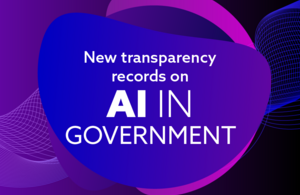New records detail how AI helps government make quick, accurate decisions to boost trade, speed up responses and more
New records reveal how algorithmic tools are being used in public services to enhance citizen support, enable quick and accurate decision-making, and drive technological improvements in critical government services.

- New records show how algorithmic tools are used by government departments and agencies to provide reliable and quicker services to the public and businesses.
- While improving transparency on the use of AI across Whitehall, the move also shows how technology is helping deliver the Plan for Change by improving public services, supporting businesses to export and more.
- Examples show how the science and technology department plans to use technology across public services in its new role as the digital centre of government.
New records show the inner workings of algorithmic tools being used to help public services to support citizens, make quick and accurate decisions, and drive forward the use of technology to improve vital government services and cut backlogs.
The Algorithmic Transparency Recording Standard (ATRS) records published today (17th December), demonstrate how, for example how:
- the Foreign, Commonwealth and Development Office is using AI to more quickly provide Britons with information when they need help abroad
- the Ministry of Justice is using algorithms to help researchers better understand how people interact with the justice system
- other departments are using AI to improve job adverts
It comes as the Science Secretary’s department continues to shape the new ‘digital centre’ of government to boost technology adoption across the public sector and improve public services, supporting all the government’s 5 missions and boosting public service reform under the Plan for Change.
Last week, the Chancellor of the Duchy of Lancaster, Pat McFadden, set out that the benefits of technology like AI must be felt in the public services as well as in the private sector, and the power of tech should be used to modernise government.
Science Secretary Peter Kyle said:
Technology has huge potential to transform public services for the better, we will put it to use to cut backlogs, save money and improve outcomes for citizens across the country.
Transparency in how and why the public sector is using algorithmic tools is crucial to ensure that they are trusted and effective. That is why we will continue to take bold steps like releasing these records to make sure everyone is clear on how we are applying and trialing technology as we use it to bring public services back from the brink.
Among the records published today, the Department for Business and Trade has revealed that it is using an algorithmic tool to predict which companies export goods to other countries, in turn driving economic growth and supporting the government’s Plan for Change.
Officials in the department are then able to make more targeted decisions about which companies they reach out and offer help to, so high potential exporting businesses can reach more international customers quickly.
Before the tool was put in place, officials had to use more manual methods to sift through data on the over 5 million companies registered on Companies House to target support – slowing down help the government could offer, and missing opportunities to support high-growth businesses.
Business Secretary Jonathan Reynolds said:
Our Plan for Change will deliver economic growth, and for that to succeed we need to support companies across the UK to realise their full potential when it comes to exporting around the globe.
Our use of AI plays a vital and growing role in that mission, allowing high-growth businesses to maximise the export opportunities available to them, while ensuring that we are using taxpayers’ money responsibly and efficiently in delivering economic stability.
New today, the government is also setting clear terms for the tools algorithmic transparency records will cover, so people know how the government is making use of AI. This confirms that central government organisations will publish a record for any algorithmic tool that interacts directly with citizens or significantly influences decisions made about people, unless a narrow set of exemptions apply such as national security. It also confirms that records will be published for tools once they are being piloted publicly or are live and running.
The records set out how reliable data is used to train AI models, what underlying technology is used in each case, and how any risks are managed effectively. In every case where civil servants use algorithmic tools to make quicker decisions, the records also show how trained staff remain behind the ultimate decision-making process.
Notes to editors
The full list of ATRS records for tools released today is as follows:
- Home Office - Complexity Application Routing Solution - Visits (CARS(V))
- DBT - Find Exporters
- FCDO - Consular Digital Triage - Written Enquiries LLM
- HMT - Correspondence Triage Automation Tool
- HMT - HMT Modelling Policy Engine
- DSIT - Ask Ops Chatbot
- DSIT - Succession Select
- MoD - Textio
- MoJ - Data First (Splink)
- NICE - NORMA (NICE-ONS Recommendation Matching Algorithm)
- Oak National Academy - Aila: Oak’s AI lesson assistant
- Cafcass - Genesys Chatbot
- MaPs - Pension Calculator
- Network Rail – Network Rail’s Digital Assistant
Find more information on the ATRS and explore the newly published records.
These records’ publication follows the ATRS becoming mandatory for all government departments earlier this year, meaning more records will be published for existing tools over the coming months.
DSIT media enquiries
Email press@dsit.gov.uk
Monday to Friday, 8:30am to 6pm 020 7215 3000